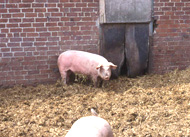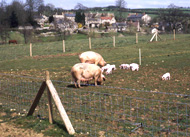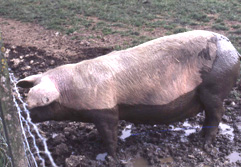NADIS Pig Health Focus – June 2007
Sunburn and Heatstroke/Heatstress
Mark White BVSc DPM MRCVS
During a warm dry spring and summer, the 2 separate conditions of sunburn and heatstroke tend to get linked together and whilst these are undoubtedly instances where the 2 conditions occur together they are distinctly different in their cause, development and consequences.
Heatstroke – known in medical terms as hyperthermia – occurs when the core body temperature rises and the normal control mechanism fails to reduce it. The pig is a relatively poor controller of its own body temperature, not sweating (other than from the snout) and if it is unable – due to environmental conditions – to wet its skin and thus allow latent heat of vaporisation to cool it (the exact process that occurs with sweating in man) it cannot lose heat from the skin. Even if able to wet the skin (wallowing, playing with water nipples etc) if humidity is very high, the water will not evaporate and thus there will be no cooling (A similar situation occurs in a sauna in man). In practice, in temperate climates, humidity is rarely such a problem.
Inevitably heatstroke occurs both indoors and outdoors.
 |  |
| Fig 1 : Gilts recently delivered have first exposure to sunlight in early Juneresulting in severe erythema typical of sunburn. | Fig 2 : Outdoor sows in summer and late spring are susceptible to sunburn. |
In the absence of wallowing or wetting, the only methods available to the pig to avoid over-heating are moving to cooler areas – such as where there are draughts or shade – and panting.
Whilst the ultimate consequences of heatstroke are disastrous i.e. death, early signs would include increased respiratory rate, attempts to lie on their sides, away from other pigs, lying in dunging passageways and excessive playing with water. An increased respiratory rate leads to more water loss (i.e. the cooling process) and thus dehydration may become an issue possibly leading to salt poisoning/water deprivation syndrome in growing pigs..
| Measures that are necessary to avoid heatstroke will depend upon the age of the animal at risk and the accommodation available. In general, however, the following points are valid:- 1) Provide adequate insulation in buildings. With its high bodyweight to surface area ratio, the adult is particularly vulnerable and other features of overheating in the longer term include:- |
In a hot summer period such as experienced in late June/July 2006 the impact of hot weather on one typical 500 sow breeder weaner unit over a 4 week period was:-

a) 6 sows died of heat stroke around farrowing
b) Farrowing Rate depressed by 11% giving a shortfall of 11 farrowings in October.
c) Depression of litter size in October by 0.9 pigs/litter = 76 piglets.
Therefore a shortfall of piglets produced in the autumn was approximately 200 piglets @ £30/pig (cost of production plus lost profit opportunity) = £6000. The impact of reduced weaning weights in piglets reared in hot weather must be added to this.
In growing pigs in very hot weather, appetite can reduce by 50% with the effect of totally stalling growth.
Sunburn – that can lead to heat stroke in itself – is a distinctly separate condition of obvious cause. It is not restricted to outdoor pig production. It tends to occur more commonly in early summer (May/June) as a result of the first exposure to strong sunlight since the winter and, in a mild form, reddening of the skin is all that is seen but, in severe cases, blistering can occur and when the back is severely affected the pig will adopt a characteristic pose with the back distinctly dipped and walking on the front knees.
Apart from the obvious pain and discomfort that sunburn produces, in some cases, it can lead to pregnancy loss (returns to service or abortion) or a failure to be served in an unsupervised regime.
It is important to remember that outdoors, water wallows will not protect against sunburn (children get sunburnt playing in the sea or in swimming pools). To be effective, the wallow must provide a thick coating of mud over the body. Shading is an alternative but litter desertion can be a major problem.
Where pigs have become severely sunburnt shade must be provided and application of an emollient cream or ‘pig oil’ may ease discomfort and aid healing. In severe cases non-steroidal anti-inflammatory painkillers are indicated on welfare grounds.
Sunburn should not be confused in outdoor situations with photosensitization normally precipitated by exposure to certain plant toxins present in eg. parsnips, carrots, rape and oats. The appearance can be similar to severe sunburn.
An online, automatically marked quiz on this subject can be found at www.nadis.org.uk
Copyright © NADIS 2007
